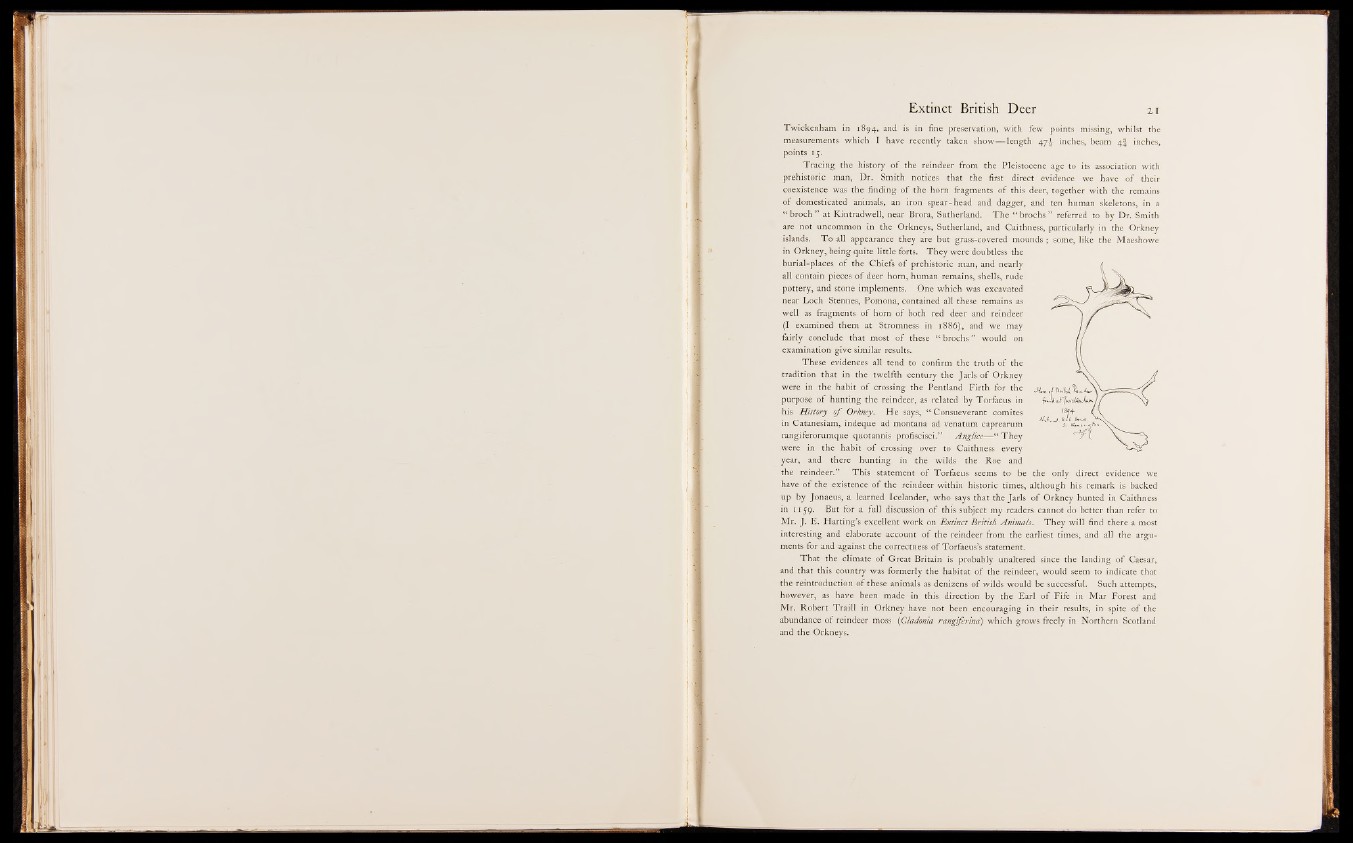
Twickenham in 1894, and ië in fine preservation, with few points missing, whilst the
measurements which I have recently taken show— length 47^ inches, beam 4 f inches,
points 15.
Tracing the history o f the reindeer from the Pleistocene age to its association with
prehistoric man, Dr. Smith notices that the first direct evidence we have o f their
coexistence was the finding o f the horn fragments o f this deer, together with the remains
o f domesticated animals, an iron spear-head and dagger, and ten human skeletons, in a
“ broch ” at Kintradwell, near Brora, Sutherland. T h e “ brochs ” referred to by Dr. Smith
are not uncommon in the Orkneys, Sutherland, and Caithness, particularly in the Orkney
islands. T o all appearance they are but grass-covered mounds ; some, like the Maeshowe
in Orkney, being quite little forts. T h ey were doubtless the
burial-places o f the Chiefs o f prehistoric man, and nearly
all contain pieces o f deer horn, human remains, shells, rude
pottery, and stone implements. One which was excavated
near Loch Stennes, Pomona,-contained all these remains as
well as fragments o f horn o f both red deer and reindeer
(I examined them at Stromness in 1886), and we may
fairly conclude that most o f these “ brochs ” would on
examination give similar results.
These evidences all tend to confirm the truth o f the
tradition that in the twelfth century the Jarls o f Orkney
were in the habit o f crossing the Pentland Firth for the
purpose o f hunting the reindeer, as related by Torfaeus in
his History o f Orkney. He says, “ Consueverant comités
in Catanesiam, indeque ad montana ad venatum caprearum
rangiferorumque quotannis profiscisci.” Anglice— “ They
/were in the habit o f crossing over to Caithness every
year, and there hunting in the wilds the Roe and
the reindeer.” This statement o f Torfaeus seems to be the only direct evidence we
have o f the existence o f the reindeer within historic times, although his remark is backed
up by Jonaeus, a learned Icelander, who says that the Jarls o f Orkney hunted in Caithness
in 1159. But for a full discussion o f this subject my readers cannot do better than refer to
Mr. J. E. Harting’s excellent work on Extinct British Animals. T hey will find there a most
interesting and elaborate account o f the reindeer from the earliest times, and all the arguments
for and against the correctness o f Torfaeus’s statement.
That the climate o f Great Britain is probably unaltered since the landing o f Caesar,
and that this country was formerly the habitat o f the reindeer, would seem to indicate that
the réintroduction o f these animals as denizens o f wilds would be successful. Such attempts,
however, as have been made in this direction by the Earl o f Fife in Mar Forest and
Mr. Robert Traill in Orkney have not been encouraging in their results, in spite o f the
abundance o f reindeer moss (Cladonia rangiferina) which grows freely in Northern Scotland
and the Orkneys.